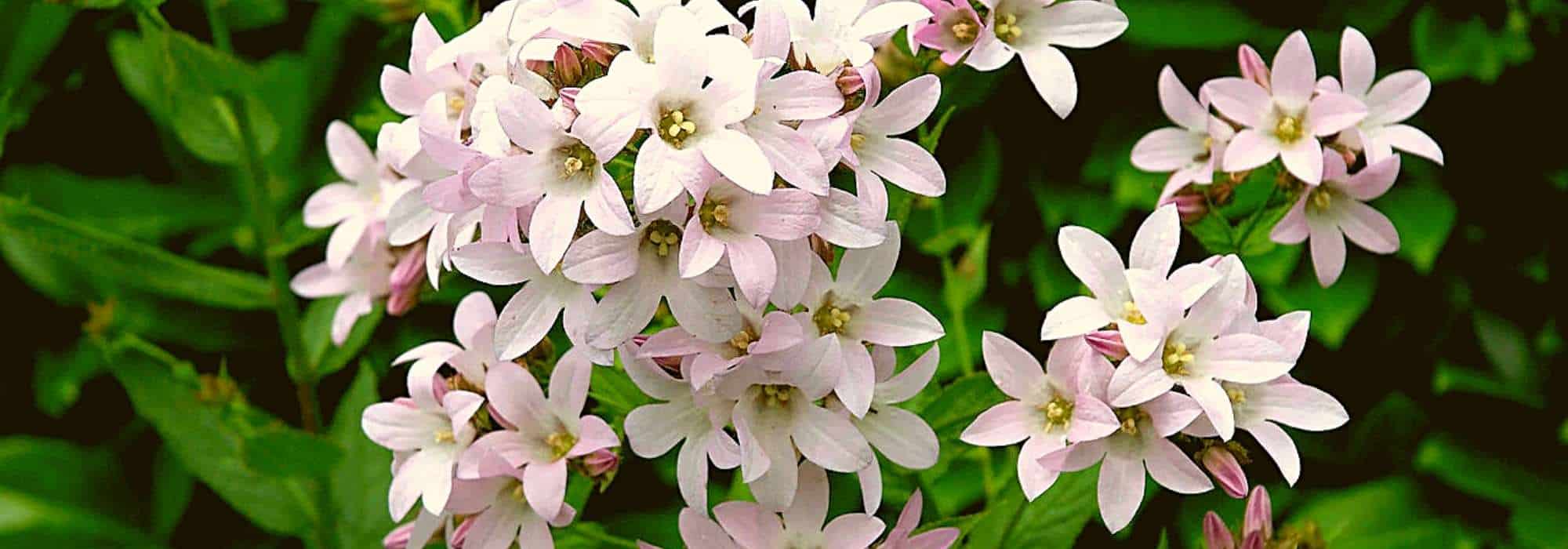
Choosing Campanulas
our buying guide to make the right choice
Contents
Campanulas are herbaceous perennials (sometimes biennial), highly valued for their bell-shaped flowers. There are several hundred varieties worldwide. Thus, some campanulas have upright flowers, while others are drooping, in shades of white, pink, and blue, with varying degrees of lobing or star shapes. They also come in all sizes, from 10 cm to 1.5 m. In the garden, they should be chosen based on height, exposure, colour, and the shape of the flowers or leaves. Other criteria such as foliage persistence, flowering period, or intended use can also be considered.
Here are our tips for choosing campanulas according to your requirements!
→ Discover our wide range of campanulas
According to its height and use
There are varieties of all sizes, such as the tiny wall bellflower, which barely exceeds 15 cm in height, or the very large Campanula latiflora that reaches 1.50 m. They can also have different habits, such as bushy, spreading, or upright. The smaller varieties are generally used as groundcovers, while the larger ones take a prominent place in a border.
Small Varieties
Small varieties of campanulas are typically dense and spreading. They are ideal for groundcover cultivation, on top of a wall, in a planter, at the feet of bushes or roses, and even in the joints of paving. Here are a few remarkable ones:
- The Carpathian bellflower is a small variety, 15 cm tall with a 30 cm spread, featuring open and upright flowers. It is ideal in pots, as groundcover, and thrives on a wall. It also comes in blue-lavender, blue-mauve, and white.
- The Campanula cochlearifolia, with its drooping bell-shaped flowers, does not exceed 15 cm in height. It is stunning in pots, in rockeries, or on a wall. The variety cochlearifolia ‘Elizabeth Oliver’ features delicate double flowers.
- The Campanula poscharskyana, or wall bellflower, reaches 30 cm in all directions and offers very starry flowers. It is perfect in containers, in borders, and in rockeries.
Medium Varieties
Medium-sized campanulas typically range from 40 to 80 cm in height. Their habit is rather bushy, making them suitable for tall groundcover, in a wildflower border, or for making bouquets. Here is a small selection:
- The campanula trachelium, with its purple bells, is perfect in an unpretentious wild garden. It measures about 75 cm tall.
- The Campanula takesimana ‘Alba’ measures 60 to 65 cm tall. Its flowers take the form of long tubular bells in a satin white.
- The Campanula glomerata ‘Superba’ is also known as ‘bouquet bellflower’ for its long stems, 50 cm tall, bearing clusters of flowers. It is often cut for vases. At ripeness, it spreads to 1 m in width.
Large Varieties
Large campanulas are ideal for the back of borders or as cut flowers. In areas very exposed to winds, the flower stems will need staking to prevent bending. Here are a few:
- The milk bellflowers are characterised by very tall flower spikes, gathered in large bouquets. The Campanula lactiflora is one of the tallest at 1.50 m. It finds its place in a natural garden or at the back of a border. Its smaller sisters, such as the Campanula lactiflora ‘Loddon Anna’ or the Campanula latifolia ‘var. macrantha’ are slightly shorter, reaching 1 m or even 1.20 m in height.
- The peach-flowered bellflower (Campanula persicafolia) offers large flower spikes in summer, reaching up to 80 cm tall. Its flowers are large and bell-shaped in a very soft blue or white for the Campanula persicifolia ‘Alba’.
- The Campanula pyramidalis ‘Alba’ is a large perennial, 1 m tall, combining charm and vigour in a very natural spirit. Rather biennial, it self-seeds spontaneously.
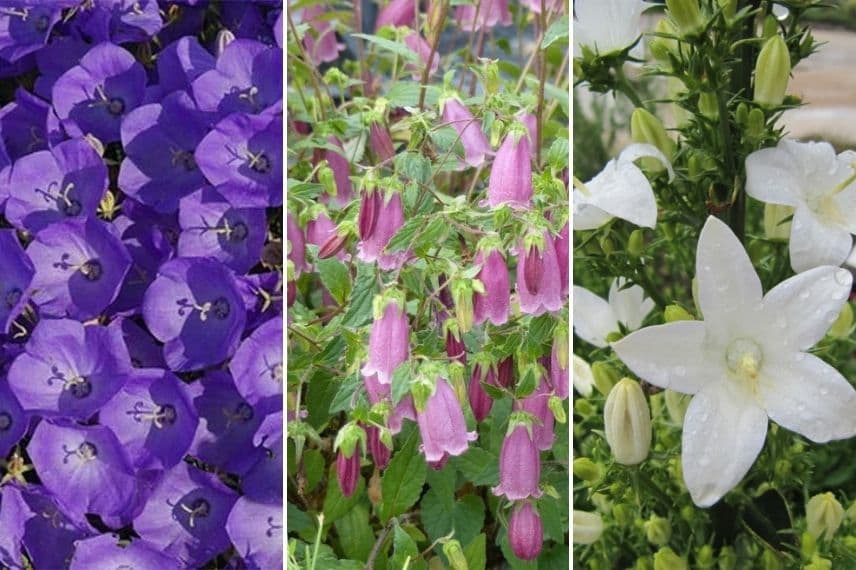 The small Campanula carpatica ‘Karl Foerster’, the medium hybrid bellflower ‘Ringsabell Mulberry Rose’, and the large Campanula pyramidalis ‘Alba’.
The small Campanula carpatica ‘Karl Foerster’, the medium hybrid bellflower ‘Ringsabell Mulberry Rose’, and the large Campanula pyramidalis ‘Alba’.
→ Discover our advice sheet: 7 large campanulas for the back of borders
Read also
5 groundcovers for clay soilDepending on the exposure
All varieties of campanulas appreciate a non-burning sunny spot or partial shade. Generally, they do not thrive in the sun of hot, dry regions, such as the Mediterranean, for example.
Only 3 varieties tolerate shade provided they have rich soil:
- The Campanula poscharskyana is a very robust variety that will thrive in light sun and shade.
- The Campanula takesimana also enjoys the damp shade of a few trees as well as gentle sun.
- The robust Campanula latifolia ‘var. macrantha’ can be planted in both sun and shade.
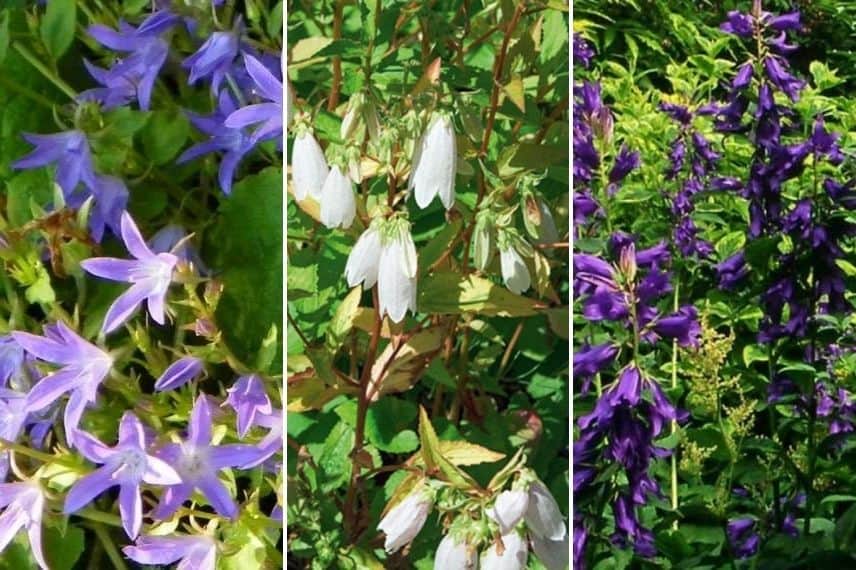 Campanula poscharskyana, Campanula takesimana and Campanula latifolia ‘var. macrantha’.” width=”856″ height=”570″ />
Campanula poscharskyana, Campanula takesimana and Campanula latifolia ‘var. macrantha’.” width=”856″ height=”570″ />Discover other Campanula - Bell Flower
View all →Available in 0 sizes
Available in 0 sizes
Available in 2 sizes
Available in 0 sizes
Available in 0 sizes
Available in 2 sizes
Available in 0 sizes
Available in 1 sizes
Available in 1 sizes
Available in 2 sizes
Depending on the colour of its flowers
Campanulas offer a gentle palette of colours: from pure white to reddish-purple, including pale blue, deep violet, and even sprinkled with pink.
Flowers are generally gathered in spikes or clusters at the ends of the stems, but they can also be solitary. They take the form of simple or double bells, long or rather open and star-shaped, or even very finely cut.
You are sure to find a shade and shape that you will love.
Blue and Purple Campanulas
Blue campanulas are the most common. The blue colour comes in multiple shades to suit all types of gardens and tastes:
- Grey-blues: Campanula lactiflora, Campanula garganica, and Campanula poscharskyana ‘Trollkind’ offer flowers of a tender lavender blue.
- Bright lavender blues: Campanula carpatica ‘Clips Blue’, and Campanula poscharskyana ‘Stella’.
- Intense blues: Campanula Sarastro, Campanula hybrid ‘Kent Belle’, and Campanula hybrid ‘Ringsabell Indigo Blue’.
- Purple campanulas: Campanula poscharskyana, Campanula glomerata ‘Joan Elliot’, and the most intense: Campanula latifolia ‘var. macrantha’.
White Campanulas
White-flowered campanulas are easily spotted, as they are mostly named ‘Alba’ (white in Latin). They bring a touch of softness to the garden. Among them, we have:
- Campanula cochleariifolia ‘Alba’ with its pure white bells contrasting with its dark green foliage.
- Campanula punctata ‘Milky Way’ offers superb double white bells that reveal a barely pink throat, all punctuated with red.
- Campanula glomerata ‘Alba’ develops lovely white flowers in the shape of open bells, grouped in clusters.
Pink Campanulas
To add a romantic touch to the garden or terrace, turn to pink campanulas:
- Campanula hybrid ‘Ringsabell Mulberry Rose’ with its long pendulous bells that are dark pink, evolving to light pink.
- Campanula poscharskyana ‘Lisduggan Variety’ is covered in numerous star-shaped lavender pink flowers. It blooms twice: from spring to early summer, then in autumn.
- Campanula glomerata ‘Caroline’ which features pale pink tubular bell flowers, bright pink at the tips, in terminal clusters.
The Reddish-Purple Campanula
Campanula punctata ‘Rubriflora’ is a superb variety, offering simple, tubular, pendulous flowers of a dark reddish-purple all summer long.
Read also
5 perennials for dry groundAccording to the shape of the flower
Star-shaped Campanulas
When the corolla of the flower is very open and deeply divided into five lobes, it takes on a true star shape, as seen in the following varieties:
- Campanula garganica with its spreading star-shaped blue mauve bells.
- Lactiflora campanulas, such as the variety ‘White Pouffe’ or ‘Alba’ with their starry white flowers, or ‘Prichard’s variety’ with light blue tones.
- Wall Campanula (Campanula portenschlagiana) with its multiple violet-blue starry flowers.
- The large Campanula pyramidalis ‘Alba’ with star-shaped white flowers.
- Peach-leaved Campanulas (with peach-like leaves), such as the variety ‘Hidcote Amethyst’.
- Carpathian Campanulas also offer wide starry flowers, for example: Campanula carpatica ‘Alba’.
Bell-shaped Campanulas
Some flowers take on a delicate bell shape, generally tubular, thin, and not deeply lobed. Here are a few:
- Hybrid Campanula ‘Ringsabell Mulberry Rose’ features long pendulous dark pink bells, evolving to light pink.
- The small Campanula ‘pulla’ with its dark violet-blue bells.
- Campanula takesimana ‘Alba’ whose flowers are very long tubular bells, inclined, with a satin white colour, barely revealing a purple-spotted throat.
- Campanula punctata ‘Rubriflora’ which offers simple, tubular, pendulous flowers in dark purplish red throughout the summer.
- Campanula ‘Sarastro’ with elegant elongated bells in a very lovely intense blue.
- Campanula cochleariifolia with its thin stems and simple flowers.
→ Learn more in our advice sheet: Bell-shaped Campanulas
Double-flowered Campanulas
A little less common, but just as sublime and delicate, double-flowered campanulas bring delicacy and poetry to the garden.
- Campanula ‘Wedding Bells’ is charming with its semi-double, pendulous bell-shaped flowers, in a cream white washed with a hint of pink.
- In the same vein, Campanula punctata ‘Milky Way’ features semi-double white flowers, sprinkled and edged with purplish pink.
- Hybrid Campanula ‘Pantaloons’ offers very beautiful semi-double flowers, bell-shaped, in violet pink with pale pink edges.
- Campanula persicifolia ‘La Belle’ is a double version of the peach-leaved campanula. It blooms for several weeks in an intense and deep lavender blue. Like its white-flowered sister, Campanula persicifolia ‘La Bello’.
Original-flowered Campanulas
‘Octopus’ Campanulas are recent and original varieties. They stand out with their flowers featuring fine, velvety petals, curled like the soft tentacles of a small octopus, while also evoking Japanese lanterns.
- Hybrid Campanula ‘Blue Octopus’ is lovely with its flowers in a blue-violet colour with a white centre.
- Hybrid Campanula ‘Pink Octopus’ bears flowers with carmine pink petals.
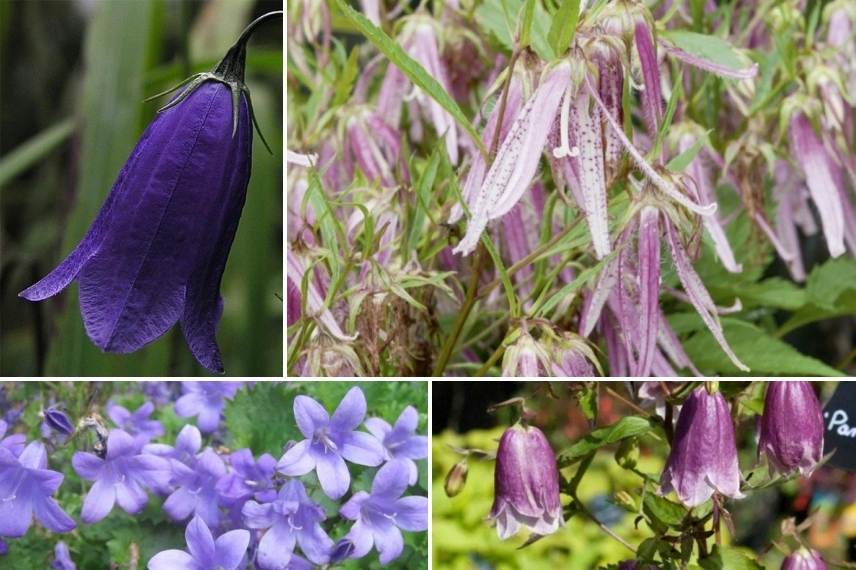
The tubular bell flower of Campanula ‘pulla’, the surprising Hybrid Campanula ‘Pink Octopus’, the starry flowers of Campanula portenschlagiana and the Hybrid Campanula ‘Pantaloons’ with its semi-double flowers.
According to the colour and shape of the foliage
Most campanulas have deciduous or semi-evergreen foliage if the winter is not too harsh. Some varieties feature very dentate and cut leaves, making them highly decorative plants.
- Campanula garganica has semi-evergreen, light green foliage with dentate leaves. This foliage consists of basal leaves that are ovate, reniform, and dentate, measuring 2.5 to 3.5 cm long, while the upper leaves are cordate and dentate.
- Campanula garganica ‘Dickson’s Gold’ is a cultivar with bright yellow or acid green, semi-evergreen leaves. It forms a cushion 15 cm high with dentate, basal leaves that are ovate, reniform, and dentate, measuring 2.5 to 3.5 cm long. The upper leaves are cordate and dentate.
- Campanula trachelium ‘Bernice’ is commonly known as “nettle-leaved campanula” or “blue nettle.” It stands out with its large, ovate to triangular, dentate leaves covered in hairs reminiscent of nettles. The deciduous foliage is a bluish green.
- Peach-leaved campanula features semi-evergreen foliage in winter that is dark green. Its leaves are lanceolate and elongated like peach leaves, hence its name.
- Campanula carpatica develops semi-evergreen foliage that is very bright and shiny green, consisting of rounded, cordate, and highly dentate leaves.
- Campanula alliariifolia has thick, cordate leaves that are 15 to 20 cm long, covered in white hairs that give them a greyish-green hue.
- Hybrid campanula ‘Iridescent Bells’ is notable for its dark green, slightly villous foliage that turns purple in autumn before disappearing.
- The leaves of Hybrid campanula ‘Ringsabell Indigo Blue’ are quite broad, slightly cordate, dentate, and glossy. They display a rather dark green colour. They are gathered in well-compact basal rosettes that redden in autumn and persist if the winter is mild.
- Campanula takesimana ‘Alba’ forms a carpet of broad, dentate leaves that are shiny light green, adding brightness to the garden. They gather in slightly loose basal rosettes. The foliage sometimes persists if the winter is mild.
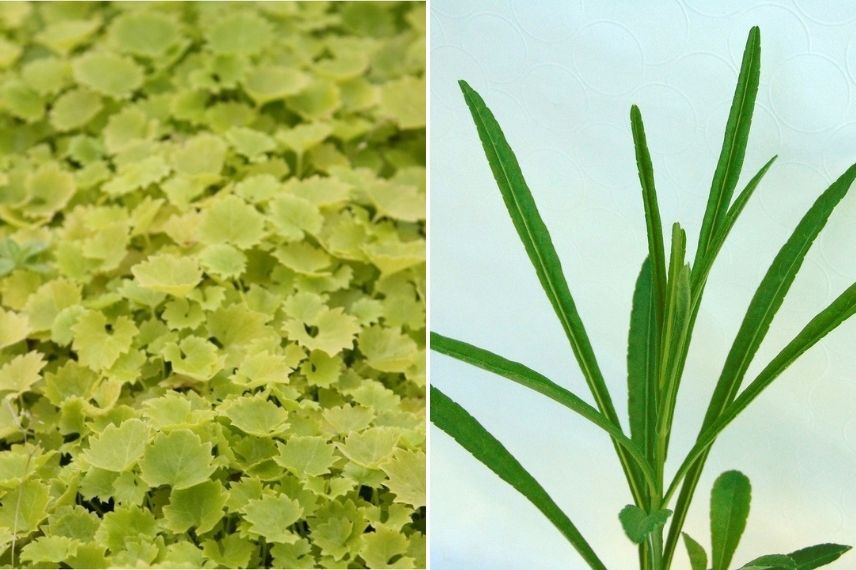
Foliage of Campanula garganica ‘Dickson’s Gold’ and Peach-leaved campanula.
According to the flowering period
Campanulas bloom abundantly during the summer season, around June and August. However, some varieties reward us with longer flowering periods extending into autumn, much to our delight.
This is the case with Campanula lactiflora ‘White Pouffe’, which produces a profusion of small, star-shaped white flowers forming a cut flower arrangement from June to October. The same goes for its sister with blue flowers: the Campanula lactiflora ‘Blue Pouffe’, as well as Campanula poscharskyana ‘Trollkind’ and its multitude of small star-shaped flowers in a rich lavender blue.
From June to October, the Campanula rotundifolia is covered in numerous small, pendulous bell-shaped flowers in lavender blue, both simple and full of charm. Just like Campanula lactiflora ‘Alba’ and its gentle white flowering.
Some early varieties, such as Campanula poscharskyana, bloom from May until autumn, but usually pause during the hot, dry summer months. Just like Campanula ‘Royal Wave’ and Campanula glomerata ‘Alba’.
Further reading:
- Discover all our campanula varieties.
- To learn everything about campanulas, find our sheet on its planting, cultivation, and maintenance.
- Subscribe!
- Contents
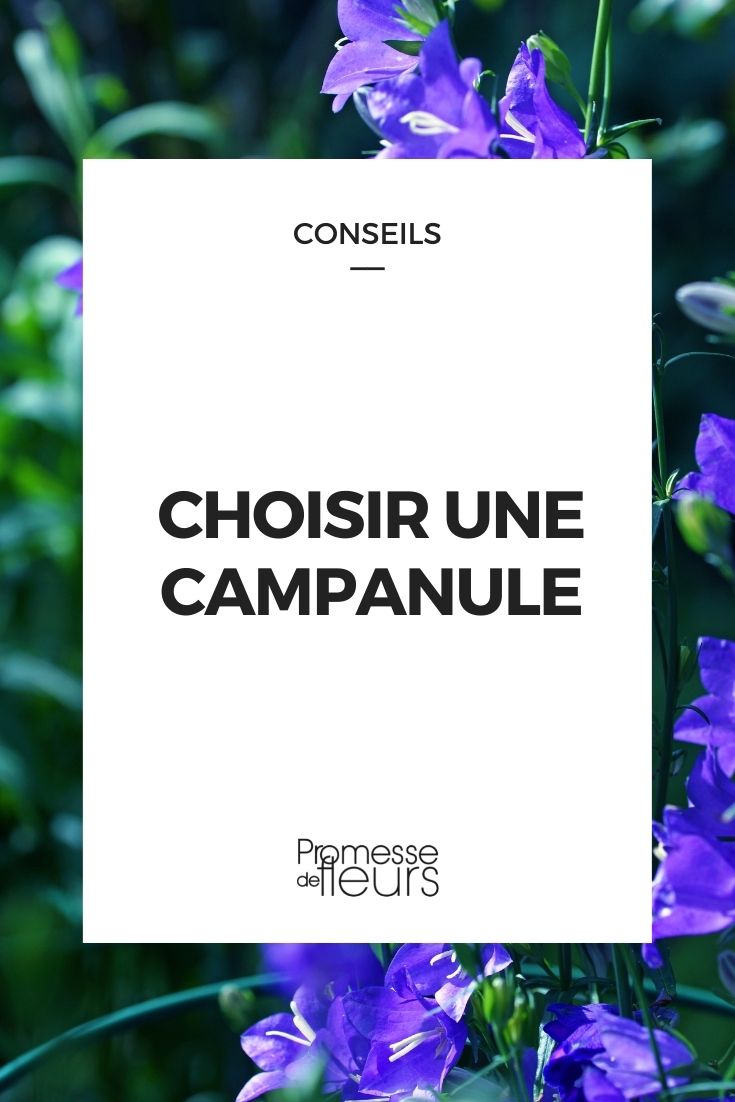































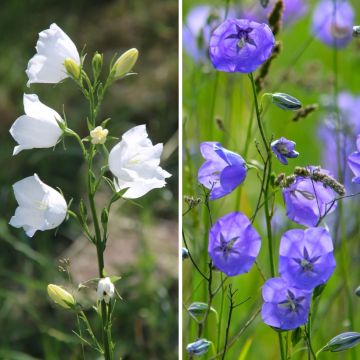
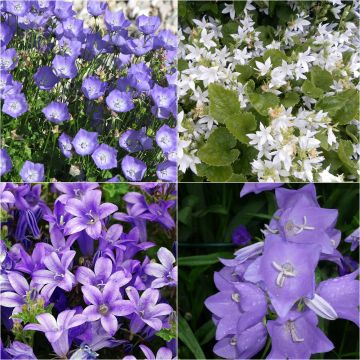
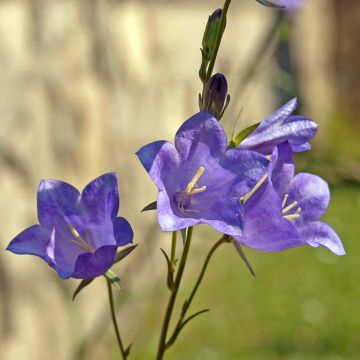

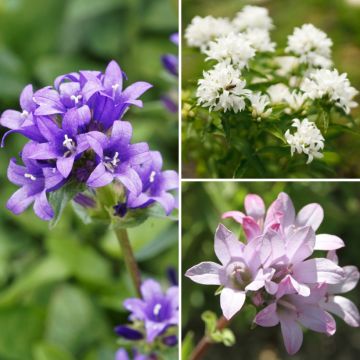
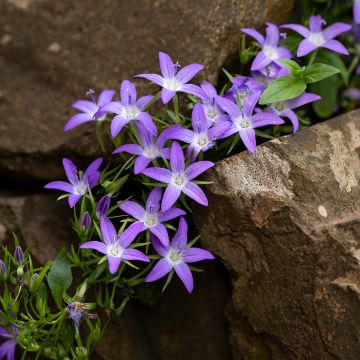
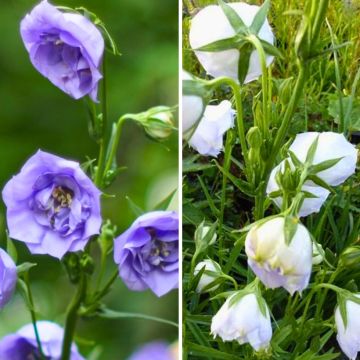
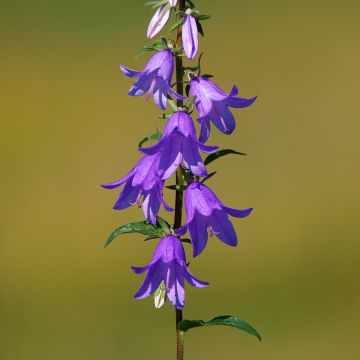
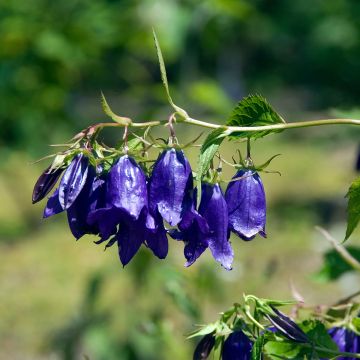
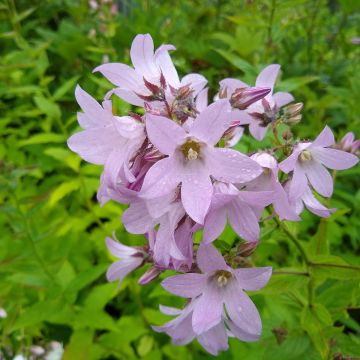
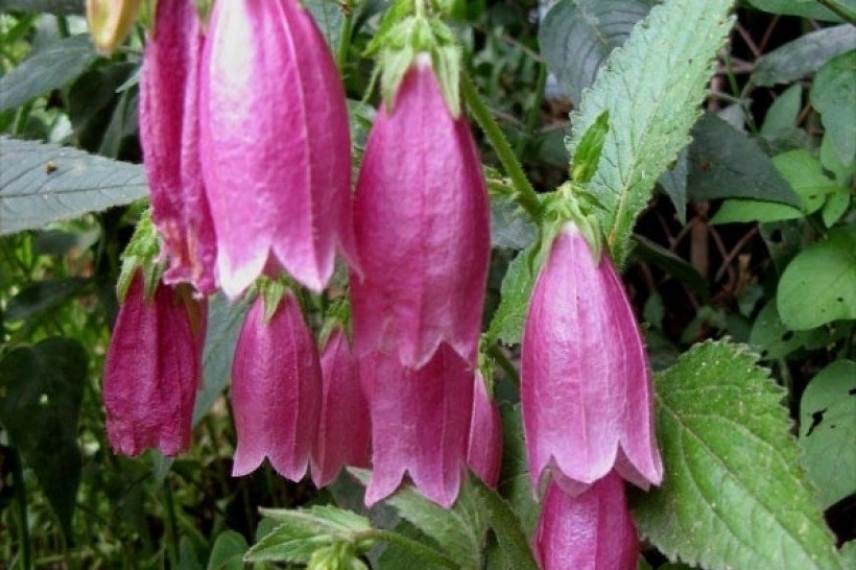
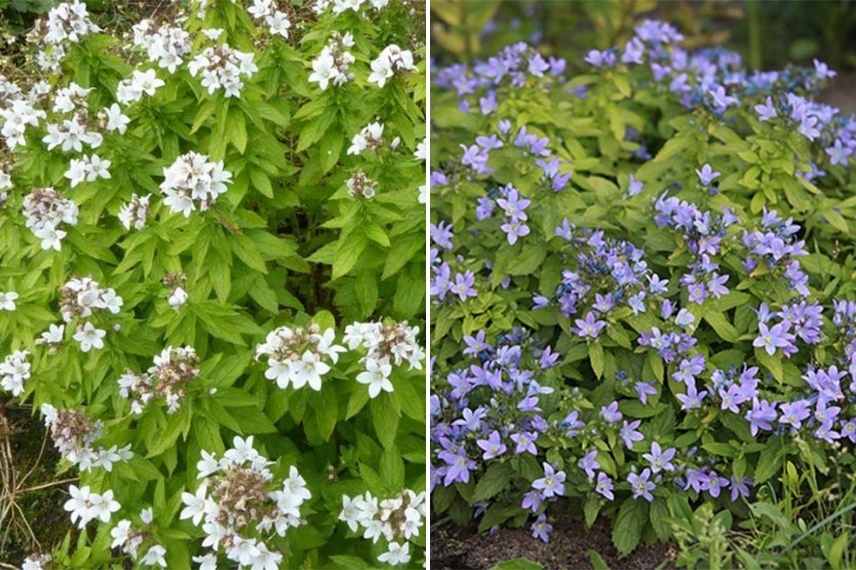
Comments